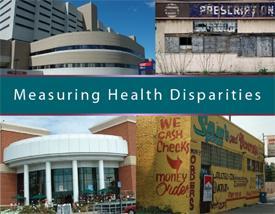
Measuring Health Disparities is designed to be accessible to a broad audience of practitioners across all sectors of the public health workforce. In contains audio and interactive elements and focuses on some basic issues for public health practice - how to understand, define, and measure health disparity.
The material is divided into four parts. Parts One and Two review what health disparities are, how they are defined, and provide and overview of common issues faced in measuring health disparities. Part Three is technical and introduces users to a range of health disparity measures, providing advantages and disadvantages of each. Part Four discusses how best to use different measures to communicate and evaluate health disparity in our communities. Parts Three and Four are more technical and, though not necessary, it is helpful to have a background in statistics, epidemiology or other sciences for ease of understanding. See the Measuring Health Disparities website for more information about this course.
Instructors: Sam Harper and John Lynch
dScribes: Pieter Kleymeer, Hung Truong
Course level: Graduate
Course Structure: This is a self-paced, interactive CD-ROM course. The complete Measuring Health Disparities course is available as a Windows executable download.
Syllabus
Course Description
This interactive course focuses on some basic issues for public health practice -- how to understand, define and measure health disparity. This course examines the language of health disparity to come to some common understanding of what that term means, explains key measures of health disparity and shows how to calculate them. This computer-based course provides a durable tool that is useful to daily activities in the practice of public health.
The material is divided into four content sections. Parts I and II review what health disparities are, how they are defined, and provide an overview of common issues faced in measuring health disparities. Parts III and IV introduce users to a range of health disparity measures, providing advantages and disadvantages of each, and discuss how best to use different measures to communicate and evaluate health disparity in our communities.
Course Methodology
This course, while self-paced, can be expected to take between two to three hours to complete. The various health disparity measures are explained with interactive slides and audio commentary. Real-world examples illustrate concepts and carefully thought-out exercises help build knowledge.
Target Audience
The course is designed to be accessible to a broad audience of practitioners across all sectors of the public health and related workforce who are concerned about the issue of health disparity. Parts III and IV are more technical; although not required, it is helpful to have a background in statistics, epidemiology, or other related sciences for ease of understanding these sections.
Continuing Education Credit and Completion Certificate
For continuing education credit or completion certificate, you may complete the entire course or the first two parts (Parts I & II). Certificates are awarded upon submission of an evaluation and successful completion of the relevant tests. (There is a post-test covering Parts I & II and another covering Parts III & IV.) The computer-based course contains a link to the evaluation and post-tests, which are online.
Parts I & II provide 1.5 Contact hours in Nursing, 1.5 credits for social work continuing education, or 1.0 Contact hours for CHES; the entire course (Parts I-IV) provides 3.3 Contact hours in Nursing, 3.3 credits for social work continuing education, or 3.0 Contact hours for CHES. Additional information about social work, nursing and CHES continuing education provisions is available on the Career Advancement page of our website.
Level
This course has been classified as "knowledgeable" by the criteria of the Council on Linkages Between Academia and Public Health Practice, based on depth of material covered and length of course.
Other
Information about scholarships, fees and refunds, cancellations, registration deadlines, certificates, ADA accommodations, and our grievance policy and procedures can be found under Help in the Frequently Asked Questions section.
Sponsors
This course has been made possible through funding from the Health Resources and Services Administration, Centers for Disease Control and Prevention, Michigan Public Health Training Center, Center for Social Epidemiology and Population Health, and Prevention Research Center of Michigan.
Download
NOTE: To install and run this course you will need Microsoft Windows 98 or newer operating system.
To request a CD-ROM version of this course (both Mac and PC users), follow this link to the Measuring Health Disparities website.
Learning Objectives
Part I: What are Health Disparities?
By the end of Part I, you should be able to:
- Know the two overarching goals of Healthy People 2010.
- Identify the dimensions of health disparity as described in Healthy People 2010.
- Provide a literal definition of the term "disparity".
- Interpret three definitions of health disparity provided in Part I.
- Distinguish between the terms "health inequality" and "health inequity," and;
- Summarize specific cases of health disparity given a graphical representation.
Part II: Issues in Measuring Health Disparities
In this section, we review the main issues you need to consider when measuring health disparities. By the end of Part II, you should be able to:
- Define relative and absolute disparity.
- Calculate relative and absolute disparity.
- Explain why relative and absolute measures can give different estimates of the extent of disparity and its trends over time.
- Recognize how accounting for the size of population sub-groups can affect measurement of disparity.
- Define a reference group.
- Describe how the choice of reference group can affect disparity measurement.
- Differentiate between groups that can be ranked and those that cannot, and;
- Describe some common issues in measuring health disparities.
Part III: Measures of Health Disparities
In this part we review the most commonly used measures of health disparity. By the end of Part III, you should be able to:
- Describe the following measures of health disparities:
- Range measures (Relative Risk, Excess Risk),
- Un-weighted regression-based measures,
- Population-weighted regression-based measures (Slope Index and Relative Index of Inequality),
- Index of disparity,
- Between-group variance and Disproportionality measures (Concentration Index, Theil, Mean Log Deviation, Gini), and;
- Describe the strengths and weaknesses of the above measures.
Part IV: Analytic Steps in Measuring Health Disparity
In this final section, we will outline a set of analytic steps and recommendations in approaching measurement of health disparities. By the end of Part IV, you should be able to:
- Describe the sequence of analytic steps in measuring health disparity, and;
- Classify the four possible scenarios for changes in health disparity and changes in overall population health over time.
Learning Outcomes
Core Competencies
COMPETENCY DOMAIN #1: ANALYTIC/ASSESSMENT SKILLS
Level: Aware Applies ethical principles to the collection, maintenance, use, and dissemination of data and information
Level: Aware Makes relevant inferences from quantitative and qualitative data
Level: Proficient Recognizes how the data illuminates ethical, political, scientific, economic, and overall public health issues
COMPETENCY DOMAIN #2: POLICY DEVELOPMENT/PROGRAM PLANNING SKILLS
Level: Aware Collects, summarizes, and interprets information relevant to an issue
COMPETENCY DOMAIN #3: COMMUNICATION SKILLS
Level: Aware Effectively presents accurate demographic, statistical, programmatic, and scientific information for professional and lay audiences
COMPETENCY DOMAIN #4: CULTURAL COMPETENCY SKILLS
Level: Knowledgeable Develops and adapts approaches to problems that take into account cultural differences
COMPETENCY DOMAIN #5: BASIC PUBLIC HEALTH SCIENCES SKILLS
Level: Aware Defines, assesses, and understands the health status of populations, determinants of health and illness, factors contributing to health promotion and disease prevention, and factors influencing the use of health services
Level: Aware Identifies and applies basic research methods used in public health
Level: Aware Applies the basic public health sciences including behavioral and social sciences, biostatistics, epidemiology, environmental public health, and prevention of chronic and infectious diseases and injuries
Level: Knowledgeable Identifies the limitations of research and the importance of observations and interrelationships
Reading List
The following resources have been identified by the course instructors as supplementary material to the topics covered by the course. When possible, the full articles and abstracts have also been provided. The availability of these items is noted below.
Articles on Theory
- Illsley R, Le Grand J. The measurement of inequality in health. In: Williams A (ed.). Health and Economics. London: Macmillan Press, 1986, pp. 12-36.
- Gakidou EE, Murray CJ, Frenk J. Defining and measuring health inequality: an approach based on the distribution of health expectancy. Bull World Health Organ 2000;78:42-54.
- Kakwani N, Wagstaff A, Vandoorslaer E. Socioeconomic inequalities in health: measurement, computation, and statistical inference. J Econometrics 1997;77(1):87-103.
- Mackenbach JP, Kunst AE. Measuring the magnitude of socio-economic inequalities in health: an overview of available measures illustrated with two examples from Europe. Soc Sci Med 1997;44:757-771.
- Pearcy JN, Keppel KG. A summary measure of health disparity. Public Health Rep 2002;117:273-280.
- Wagstaff A. The bounds of the concentration index when the variable of interest is binary, with an application to immunization inequality. Health Econ 2005; 14:429-432.
- Wagstaff A. Inequality aversion, health inequalities and health achievement. J Health Econ 2002;21(4):627-41.
- Wagstaff A, Paci P, van Doorslaer E. On the measurement of inequalities in health. Soc Sci Med 1991;33:545-57.
- Wagstaff A, Van Doorslaer E. Overall versus socioeconomic health inequality: a measurement framework and two empirical illustrations. Health Econ 2004;13:297-301.
Empirical Applications
- Crimmins EM, Saito Y. Trends in healthy life expectancy in the United States, 1970-1990: gender, racial, and educational differences. Soc Sci Med 2001;52(11):1629-41.
- Duleep HO. Measuring socioeconomic mortality differentials over time. Demography 1989;26:345-351.
- Elo IT, Preston SH. Educational differentials in mortality: United States, 1979-85. Soc Sci Med 1996;42:47-57.
- Feldman JJ, Makuc DM, Kleinman JC, Cornoni-Huntley J. National trends in educational differentials in mortality. Am J Epidemiol 1989;129:919-933.
- Hahn RA, Eaker E, Barker ND, Teutsch SM, Sosniak W, Krieger N. Poverty and death in the United States–1973 and 1991. Epidemiology 1995;6:490-497.
- Keppel KG, Pearcy JN, and Wagener DK. Trends in racial and ethnic-specific rates for the health status indicators: United States, 1990–98. Hyattsville, MD: National Center for Health Statistics, 2002; (PHS) 2002-1237. (Healthy People 2000 Statistical Notes, no.23).
- Krieger N, Chen JT, Waterman PD, Rehkopf DH, Subramanian SV. Painting a truer picture of us socioeconomic and racial/ethnic health inequalities: the public health disparities geocoding project. Am J Public Health 2005;95(2):312-23.
- Pamuk ER. Social class inequality in mortality from 1921 to 1972 in England and Wales. Population Studies 1985;39:17-31.
- Pamuk ER. Social-class inequality in infant mortality in England and Wales from 1921 to 1980. European Journal of Population 1988;4:1-21.
- Pappas G, Queen S, Hadden W, Fisher G. The increasing disparity in mortality between socioeconomic groups in the United States, 1960 and 1986 [published erratum appears in N Engl J Med 1993 Oct 7;329(15):1139]. N Engl J Med 1993;329:103-109.
- Schalick LM, Hadden WC, Pamuk E, Navarro V, Pappas G. The widening gap in death rates among income groups in the United States from 1967 to 1986. Int J Health Serv 2000;30:13- 26.
- Singh GK et al. Area Socioeconomic Variations in U.S Cancer Incidence, Mortality, Stage, treatment, and Survival, 1975-1999. Bethesda, Maryland: National Cancer Institute, 2003. (NCI Cancer Surveillance Monograph Series, Number 4.) http://seer.cancer.gov/publications/ses/.
- Singh GK, Miller BA, Hankey BF, Feuer EJ, Pickle LW. Changing area socioeconomic patterns in U.S. cancer mortality, 1950-1998: Part I-all cancers among men. J Natl Cancer Inst 2002;94:904-15.
- Singh GK, Miller BA, Hankey BF. Changing Area Socioeconomic Patterns in U.S. Cancer Mortality, 1950-1998: Part II-Lung and Colorectal Cancers. J Natl Cancer Inst 2002;94:916- 25.
- Steenland K, Henley J, Thun M. All-cause and cause-specific death rates by educational status for two million people in two American Cancer Society cohorts, 1959-1996. Am. J. Epidemiol. 2002;156:11-21.
Sources for Data on Health Disparities
- National Center for Health Statistics Data Warehouse (http://www.cdc.gov/nchs/datawh/ftpserv/ftpdata/ftpdata.htm)
- U.S. National Health and Nutrition Examination Survey (http://www.cdc.gov/nchs/nhanes.htm)
- U.S. National Health Interview Survey (http://www.cdc.gov/nchs/nhis.htm)
- U.S. National Vital Statistics System (http://www.cdc.gov/nchs/nvss.htm)
- World Health Organization Statistical Information System—WHOSIS http://www3.who.int/whosis/menu.cfm
- CDC’s Behavioral Risk Factor Surveillance System (http://www.cdc.gov/brfss/)
- Inter-University Consortium for Political and Social Research (http://www.icpsr.umich.edu/)
Scientific Journals
- American Journal of Public Health (http://www.ajph.org)
- American Journal of Epidemiology (http://www.aje.oupjournals.org/)
- International Journal of Epidemiology (http://ije.oupjournals.org/)
- Health Economics (http://www3.interscience.wiley.com/cgi-bin/jhome/5749)
- Health Services Research (http://www.blackwellsynergy. com/servlet/useragent?func=showIssues&code=hesr)
- Journal of Health Economics (http://www.sciencedirect.com/science/journal/01676296)
- Social Science and Medicine (http://www.sciencedirect.com/science/journal/02779536)
- Journal of Epidemiology & Community Health (http://jech.bmjjournals.com/)
Other Resources on Health Disparities
- Healthy People 2010 (http://www.healthypeople.gov/)
- National Cancer Institute Center to Reduce Cancer Health Disparities (http://crchd.nci.nih.gov/)
- NIH National Center on Minority Health and Health Disparities (http://ncmhd.nih.gov/)
- CDC’s Office of Minority Health (http://www.cdc.gov/omh/default.htm)
About the Creators

John Lynch
Dr. John Lynch is an epidemiologist, trained in Australia and the U.S. During his work on this course, he held joint appointments at the University of Michigan in the Center for Social Epidemiology and Population Health, Department of Epidemiology at the School of Public Health, the Institute for Social Research, and the Center for Human Growth and Development.
His major research focus is in the area of social inequalities in health. He has two major research themes that explore the extent and causes of health inequalities within and between countries and over time. The first explores how social structures and policies influence health and development over the lifecourse and processes related to the intra-generational accumulation of health disadvantage. In addition, he is interested in how social and health disadvantage are transmitted to children to influence the development of health inequalities in the next generation. The second research theme concerns the environmental and place characteristics that affect health, and increasingly how these impact the developmental context for children and adolescents.
He is currently at McGill University, Department of Epidemiology, Biostatistics, and Occupational Health.
- PhD University of California at Berkeley
- M.P.H. University of California at Berkeley
- M. Ed. University of Western Australia
- B.H.M.S. University of Queensland, Australia
- B.A. University of Queensland, Australia

Jump to:
| Document Title | Creator | Downloads | License |
|---|---|---|---|
|
Syllabus |
Sam Harper
John Lynch
|
| Document Title | Creator | Downloads | License |
|---|---|---|---|
|
Learning Objectives |
Sam Harper
John Lynch
|
||
|
Resource and Reading List |
Sam Harper
John Lynch
|
||
|
Summary of Commonly Used Measures |
Sam Harper
John Lynch
|
| Document Title | Creator | Downloads | License |
|---|---|---|---|
|
All Lectures |
Sam Harper
John Lynch
|
||
|
Lecture: Part I |
Sam Harper
John Lynch
|
||
|
Lecture: Part II |
Sam Harper
John Lynch
|
||
|
Lecture: Part III |
Sam Harper
John Lynch
|
||
|
Lecture: Part IV |
Sam Harper
John Lynch
|
| Document Title | Creator | Downloads | License |
|---|---|---|---|
|
A Summary Measure of Health Disparity |
Jeffrey N. Pearcy
Kennetch G. Keppel
|
||
|
Area Socioeconomic Variations in U.S. Cancer Incidence, Mortality, Stage, Treatment, and Survival, 1975–1999 |
Gopal K. Singh
Barry A. Miller
Benjamin F. Hankey
Brenda K. Edwards
|
||
|
Education Differentials in Mortality: United States, 1979-85 (Abstract) |
Irma T. Elo
Samuel H. Preston
|
||
|
Inequality Aversion, Health Inequalities and Health Achievement |
Adam Wagstaff
|
||
|
Measuring Socioeconomic Mortality Differentials Over Time |
Harriet Orcutt Duleep
|
||
|
Measuring the Magnitude of Socio-Economic Inequalities in Health: An Overview of Available Measures Illustrated with Two Examples from Europe (Abstract) |
Johan P. Mackenbach
Anton E. Kunst
|
||
|
On the Measurement of Inequalities in Health (Abstract) |
Adam Wagstaff
Pierella Paci
Eddy van Doorslaer
|
||
|
Socioeconomic Inequalities in Health: Measurement, Computation, and Statistical Inference (Abstract) |
Nanak Kakwani
Adam Wagstaff
Eddy van Doorslaer
|
||
|
The Increasing Disparity in Mortality between Socioeconomic Groups in the United States, 1960 and 1986 |
Gregory Pappas
Susan Queen
Wilbur Hadden
Gail Fisher
|
||
|
Trends in Health Life Expectancy in the United States, 1970-1990: Gender, Racial and Educational Differences (Abstract) |
Eileen M. Crimmins
Yasuhiko Saito
|
||
|
Trends in Racial and Ethnic-Specific Rates for the Health Status Indicators: United States, 1990-98 |
Kenneth G. Keppel
Jeffrey N. Pearcy
Diane K. Wagener
|



